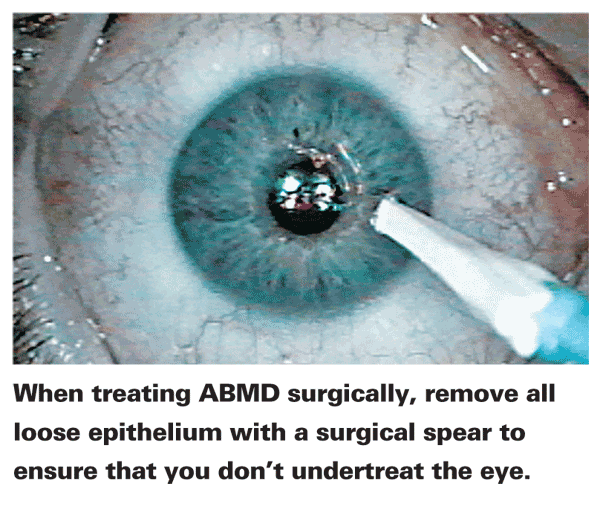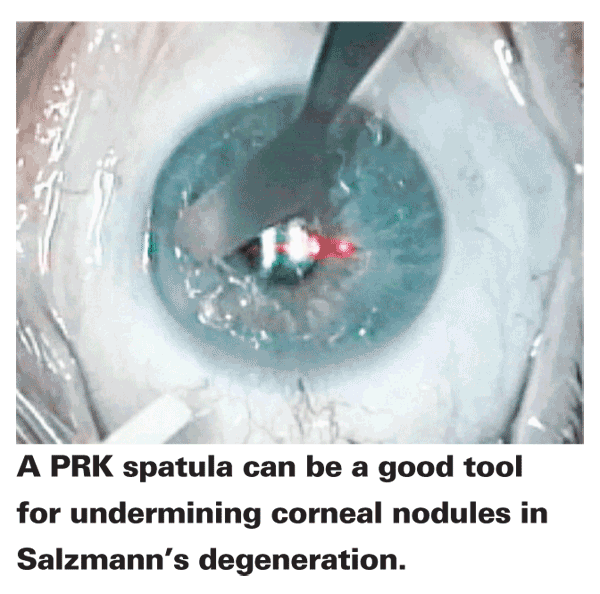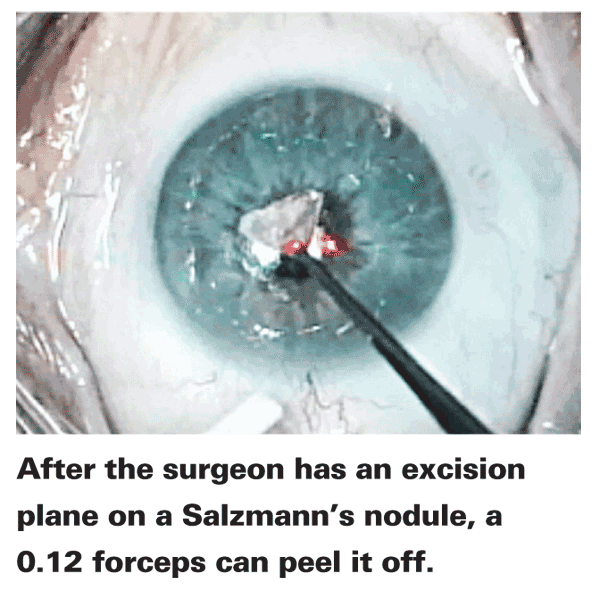No one would perform cataract surgery on a post-refractive surgery patient without using every method possible to ensure the most accurate keratometry possible.
However, if a refractive surgeon performs refractive surgery on a patient with anterior basement membrane dystrophy without treating the ABMD first and then letting the refraction stabilize, his results can be just as unpredictable, since the ABMD can affect the refraction in ways the surgeon can't foresee. In this article, I'll explain how I approach ABMD patients, and patients with Salzmann's nodular degeneration, who desire refractive surgery.
ABMD Breakdown
First, before you do any refractive surgery, if you find ABMD in a patient, it's imperative to inform him of the diagnosis. This is because it's possible for you to treat the ABMD successfully, but if the patient wasn't fully informed of the condition and it's potential effect on his surgery, he'll think the surgery caused the ABMD.
After diagnosing it, some would argue that you can just perform PRK on the patient (for the most part, LASIK is contraindicated in ABMD). The contention is that the PRK will take care of the ABMD in a manner similar to PTK, as well as inducing the refractive change. However, I don't feel this is the most effective way of managing this. The problem with this combined approach is that the ABMD affects the refraction, so one doesn't know how much of the refractive error is caused by the irregular epithelium.

To get an idea of ABMD's effect, I studied 20 refractive surgery patients in my practice who had the condition. After treating their ABMD, but before performing their refractive procedure, I recorded the shift in their refractive error that the ABMD had caused. I found that it actually ranged from zero to 1.25 D, with a mean change of 0.64 after the ABMD treatment. This means if I were to just treat their ABMD and their refractive error at one sitting, I could be off by as much as 1.25 D. Even if the patient only shifted 0.64 D, that's still enough to give him 20/40 vision after refractive surgery and make him unhappy.
Also, treating the ABMD first helps ensure better healing with the subsequent refractive procedure. If you treat both at one sitting, healing will be delayed, which can affect the final refractive outcome as well. Therefore, I think it's much easier to treat the epithelium first and come back to do the refractive PRK or LASIK later, than to treat both the ABMD and the refractive error and run a higher risk of needing an enhancement.
My treatment for ABMD is superficial keratectomy with a diamond burr. First, I remove all loose epithelium with a Merocel spear. This ensures that I don't undertreat the cornea.
If a section of the epithelium is adherent, you may not have to treat that portion of the cornea. I then get a handheld diamond burr and lightly treat the entire exposed basement membrane. I don't press hard or go deep with the burr, instead I use just enough pressure to roughen the area. I do this twice to make sure I treat the entire surface. Also, though localized areas of erosion are possible in cases of trauma, in most cases of ABMD you're likely to be treating the entire cornea.
In terms of the postop regimen, I treat the patient like a PRK case. Afterward, it's important to inform him that, since he has a large epithelial abrasion, it will take up to two weeks for it to heal.
After the superficial keratectomy but before the refractive procedure, my medical therapy begins. This therapy includes matrix metalloproteinase inhibitors such as oral doxycycline and topical steroids, which promote epithelial adhesion. I'll often give patients doxycycline 50 mg b.i.d. for a month and then q.d. for a month postop. For the topical steroid, I use the standard PRK taper. I'll also recommend that the patient use hypertonic Muro ointment at bedtime after the cornea is re-epithelialized, starting it preoperatively and continuing it for a couple of months postop, for as long as the patient can tolerate it.
I'll wait six weeks to two months to do the refractive procedure. At that point, LASIK and PRK are options.
Salzmann's Degeneration
Salzmann's nodular degeneration is different from ABMD in that it can cause significant refractive changes and, since it's a reaction to chronic, low-grade keratitis from severe dry eye, it can recur. In a study of Salzmann's effect on the refraction that I performed on a dozen patients at my practice, I found it induces an average shift of 1.71 D in the sphere and 1.57 D in the cylinder, with a large range of 0.5 to 6.5 D of sphere and 0.25 to 4.5 D of astigmatism.
Salzmann's must always be pre-treated before refractive surgery because it can progress, which will lead to future refractive shifts. With PRK, for instance, if you laser over a nodule, it will block the excimer ablation, which will result in irregular astigmatism and possibly decreased best-corrected vision. Or, if you remove the nodule and perform refractive surgery at the same time, an unpredictable outcome will result.

For the Salzmann's patient, I first try to control the dry eye with tears, cyclosporine, low-dose steroids and/or oral Omega-3 fatty acids, depending on the severity of the dry eye. I'll also treat any lid margin disease with warm compresses and/or azithromycin. You have to emphasize to these patients that their eyes aren't going to heal normally after refractive surgery and, if you perform surface ablation, they'll take longer to heal than the usual five to seven days. Also, remind them that since they have chronic dry eye there is a risk that the nodules will recur.

I then perform surgery to remove the nodules. Unlike the surgical management of ABMD, with nodules I don't remove all the epithelium, just the abnormal epithelium and the nodules themselves. It's important to use a Merocel spear to check where the epithelium is adherent or loose, and remove it anywhere it's loose, as well as over the area of a nodule. Once I get an excision plane on a nodule, I peel it off with a PRK spatula or a 0.12 forceps. I also use mitomycin in these cases to prevent the nodules from recurring and to reduce the scarring. Though I haven't witnessed recurrences in the short term, I have seen patients in whom the nodules returned after five to seven years.
Once the surface has healed, I prefer surface ablation to LASIK, because of the latter's risk of exacerbating dry eye. I'll keep the patient on his medication long-term to keep the refraction stable and prevent the nodules from returning.
Though patients with corneal dystrophies and degenerations can be more challenging than most, if you pre-treat them and educate them about their disease I've found they can be the most appreciative refractive surgery patients.
Dr. Piracha is president of the American Board of Eye Surgeons and medical director of John-Kenyon American Eye Institute in











